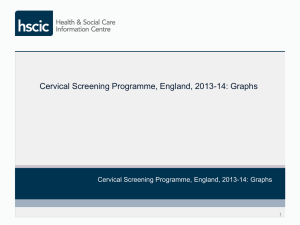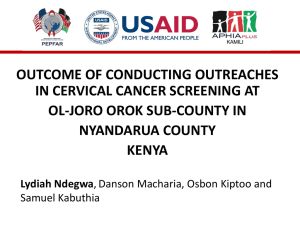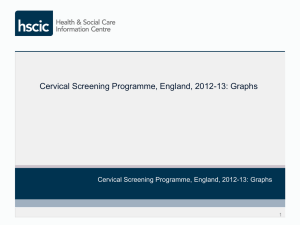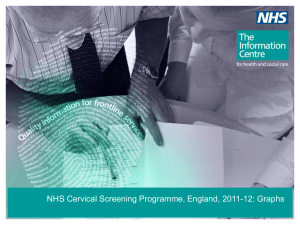Soundbites Transcribed
advertisement
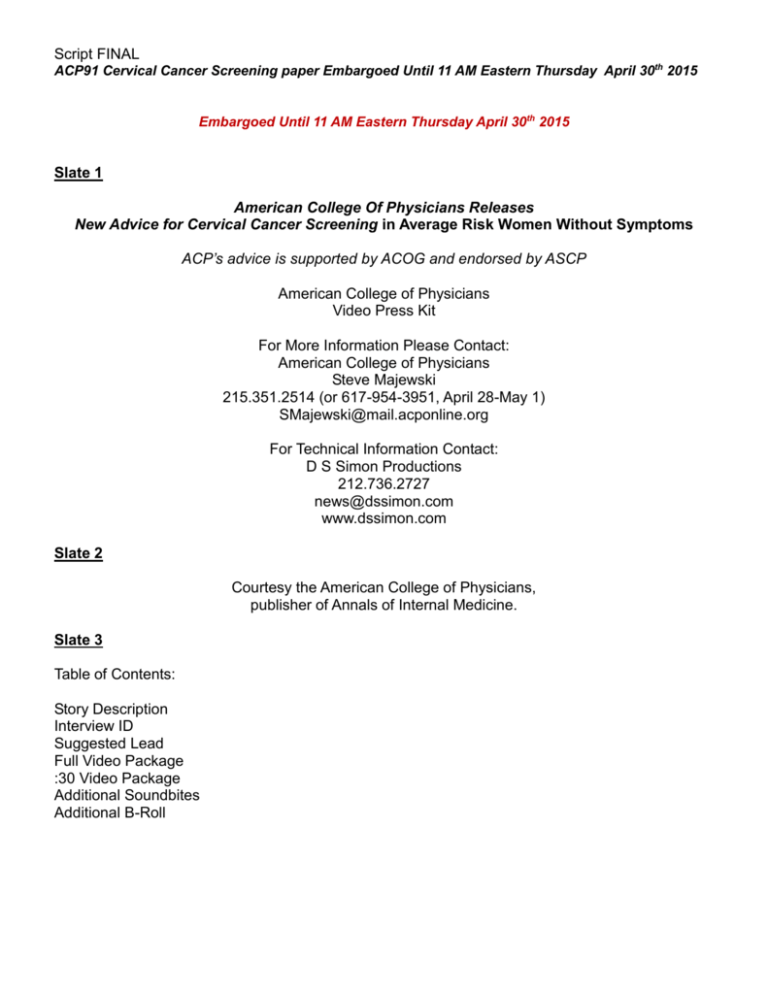
Script FINAL ACP91 Cervical Cancer Screening paper Embargoed Until 11 AM Eastern Thursday April 30th 2015 Embargoed Until 11 AM Eastern Thursday April 30th 2015 Slate 1 American College Of Physicians Releases New Advice for Cervical Cancer Screening in Average Risk Women Without Symptoms ACP’s advice is supported by ACOG and endorsed by ASCP American College of Physicians Video Press Kit For More Information Please Contact: American College of Physicians Steve Majewski 215.351.2514 (or 617-954-3951, April 28-May 1) SMajewski@mail.acponline.org For Technical Information Contact: D S Simon Productions 212.736.2727 news@dssimon.com www.dssimon.com Slate 2 Courtesy the American College of Physicians, publisher of Annals of Internal Medicine. Slate 3 Table of Contents: Story Description Interview ID Suggested Lead Full Video Package :30 Video Package Additional Soundbites Additional B-Roll Script FINAL ACP91 Cervical Cancer Screening paper Embargoed Until 11 AM Eastern Thursday April 30th 2015 Slate 4 Story Description: The American College of Physicians (ACP) has released clinical advice for cervical cancer screening in average risk women without symptoms. “Cervical Cancer Screening in Average Risk Women” is published in Annals of Internal Medicine and lists two concurring organizations: the American Congress of Obstetricians and Gynecologists and the American Society for Clinical Pathology. ACP’s Best Practice Advice is based on a distillation of relevant publications, including systematic reviews. ACP’s advice for cervical cancer screening is designed to maximize the benefits and minimize the harms of testing. Historically, physicians have low adherence to cervical cancer screening recommendations, beginning screening too early, performing screening too often, and continuing to screen women at low risk, either by age criteria or after hysterectomy with removal of cervix. ACP advises that physicians should start screening average risk women for cervical cancer at age 21 once every three years with cytology tests alone. Physicians may use a combination of cytology and HPV (human papillomavirus) testing once every five years in average risk women age 30 and older who prefer screening less often than every three years. Physicians should stop screening average risk women older than 65 years for cervical cancer who have had three consecutive negative cytology results or two consecutive negative cytology plus HPV test results within 10 years with the most recent test performed within five years. ACP further advises that physicians should not screen average risk women younger than 21 years for cervical cancer or screen average risk women for cervical cancer with cytology more often than once every three years. Physicians should not perform HPV testing in average risk women younger than 30 years or screen average risk women of any age for cervical cancer who had a hysterectomy with removal of cervix. The harms of screening average risk women without symptoms for cervical cancer include discomfort with speculum examinations and colposcopies, pain and bleeding with cervical biopsies and excisional treatments, prolonged surveillance, potential adverse obstetrical outcomes with some excisional treatments and false positive testing. Slate 5 Interview Id Tanveer P. Mir, MD, MACP American College of Physicians Clinical Guidelines Committee Associate Professor of Medicine Laura and Isaac Permutter Cancer Center NYU Langone Medical Center Script FINAL ACP91 Cervical Cancer Screening paper Embargoed Until 11 AM Eastern Thursday April 30th 2015 Slate 6 Suggested lead in: New advice from the American College of Physicians aims to inform women about the benefits and harms of cervical cancer screening. The group says that some women can benefit from less screening. Slate 7 Full package: (1) Announcer: More testing is not always better, even when it comes to cervical cancer screening. The American College of Physicians has new advice on when to start, with what test, and how often to screen women at average risk for the disease. Dr. Tanveer Mir (2) Dr. Tanveer Mir: ACP’s advice is designed to maximize the benefits and reduce the harms for cervical screening in average risk women. What it means is that frequency of testing, the initial testing age, and when to stop testing are important. Historically, physicians have started testing too frequently, too early, and they haven't stopped at the right time. This yields to potential of harms. (3) Announcer: The new advice paper, published in Annals of Internal Medicine, lists two concurring organizations: the American Congress of Obstetricians and Gynecologists and the American Society for Clinical Pathology. ACP offers this advice for screening: (4) Dr. Tanveer Mir: For women at an average risk, ACP advises that screening start at age twenty one with cytology for cervical cancer. Then at age thirty, HPV, or human papilloma virus screening, and cytology can be combined. Subsequent to that, patients can be screened every three to five years depending on their personal preference and this is a discussion they need to have with their physician so that they can have a shared decision making. (5) Announcer: Women of any age who had a hysterectomy with removal of cervix should not be screened for cervical cancer. Average risk women who are over 65 who have had several negative test results can stop being screened. Script FINAL ACP91 Cervical Cancer Screening paper Embargoed Until 11 AM Eastern Thursday April 30th 2015 (6) Dr. Tanveer Mir: The likelihood of a woman having an abnormal test for cervical screening depends on the age and the frequency of the testing. ACP recommends testing at the right age, at the right intervals, and the right time. (7) Announcer: The harms of unnecessary screening can be significant (8) Dr. Tanveer Mir: The harms of screening are discomfort of examination and undergoing the test. These would be pelvic discomforts, sometimes bleeding. And then also, for women who are of younger age, it leads to obstetric complications during delivery. So these are unknown harms. In addition to that, overtesting has been shown to increase the procedure rates like colposcopies, biopsies, and cone biopsies. (9) Announcer: By following ACP’s Best Practice Advice, physicians can practice high value care by reducing over-screening, over treatment, and unnecessarily higher costs. (10) Dr. Tanveer Mir: ACP’s advice is for average risk women who are asymptomatic to have a discussion with the physician about the frequency of testing and when to stop testing. (11) Announcer: ACP’s advice applies to women without symptoms who are at average risk, such as those with no prior history of a precancerous lesion or cervical cancer. For more information go to acponline.org. Slate 8 :30 version (1) Announcer: More testing is not always better, even when it comes to cervical cancer screening. The American College of Physicians has new advice on when to start, with what test, and how often to screen women at average risk for the disease. Dr. Tanveer Mir (2) Dr. Tanveer Mir: ACP’s advice is to maximize the benefits of cervical screening for patients. Historically, physicians have screened too early, too frequently, Script FINAL ACP91 Cervical Cancer Screening paper Embargoed Until 11 AM Eastern Thursday April 30th 2015 without improving the outcomes. ACP’s advice is to start screening at the right time, at the right intervals, and to stop screening at the right time. website (3) Announcer: For more information go to acponline.org. Slate 9 Additional Soundbites B-roll bites: The ACP advice is meant for women with average risk who are asymptomatic. High risk women would be someone with a history of cervical cancer or abnormal tests in the past. Women who are immunocompromised, for example HIV, or women who have been exposed to DES in utero or diethylstilbestrol. The risk of abnormal tests in terms of cytology is significantly higher, in women below the age of twenty one and does not lead to any significant added risk of cervical cancer in the future. So testing below the age of twenty one has been shown to be of low value without any added benefit to the patient. ACP best practice advice is not to screen women under the age of thirty for human papilloma virus. The risk of false positives is significantly higher without improving the outcomes. It is recommended that pap smears, or the cytology screening, be started at age twenty one. Not earlier. And then to continue screening every three years or so. At age thirty, patients or women can undergo screening with both the HPV and the cytology. Slate 10 Additional B-roll Slate 11 Courtesy the American College of Physicians, publisher of Annals of Internal Medicine ###
